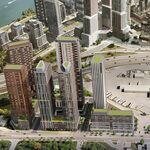Admiral Beez
Superstar
Instead of the urban highways in Toronto, could these have been served by railways?
DVP - proposed 1954. Construction began 1958. Opened 1961-1966.
Gardiner Express - proposed 1947. Construction began 1956. Opened (entirely) 1966.
QEW Expansion (427 to Gardiner). Construction began 1957. Opened 1958.
Hwy 427. Construction began 1953 (widening original hwy 27). Opened 1956.
Based on the above, how could we use railways to replace these highways? We'd need to force this idea in the automobile/suburban loving early 1950s - did anyone in North American city planning have this level of insight?
We'd still need road access, so the focus is more on moving commuters and freight into/out of Toronto without cars and trucks.
My thinking here is inspired by these "what if" planning maps http://www.wired.com/2013/08/hyperreal-cartography-city-maps/
DVP - proposed 1954. Construction began 1958. Opened 1961-1966.
Gardiner Express - proposed 1947. Construction began 1956. Opened (entirely) 1966.
QEW Expansion (427 to Gardiner). Construction began 1957. Opened 1958.
Hwy 427. Construction began 1953 (widening original hwy 27). Opened 1956.
Based on the above, how could we use railways to replace these highways? We'd need to force this idea in the automobile/suburban loving early 1950s - did anyone in North American city planning have this level of insight?
We'd still need road access, so the focus is more on moving commuters and freight into/out of Toronto without cars and trucks.
My thinking here is inspired by these "what if" planning maps http://www.wired.com/2013/08/hyperreal-cartography-city-maps/
Last edited:
















